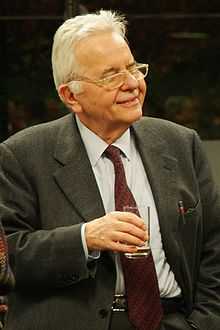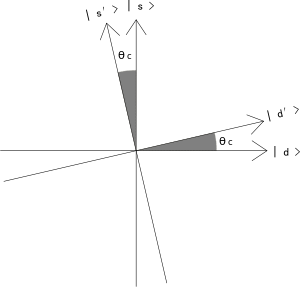Nicola Cabibbo
| Nicola Cabibbo | |
|---|---|
 | |
| Born |
10 April 1935 Rome, Italy |
| Died |
16 August 2010 (aged 75) Rome, Italy |
| Nationality | Italian |
| Fields | Particle physics |
| Institutions |
Italian National Institute of Nuclear Physics Pontifical Academy of Sciences |
| Known for | Cabibbo angle |
| Notable awards |
Sakurai Prize (1989) Matteucci Medal (2002) Pomeranchuk Prize (2009) P.A.M. Dirac Medal (2010) Benjamin Franklin Medal (2011, posthumous) |
Nicola Cabibbo (10 April 1935 – 16 August 2010[1]) was an Italian physicist, best known for his work on the weak interaction. He was also the president of the Italian National Institute of Nuclear Physics from 1983 to 1992, and from 1993 until his death he was the president of the Pontifical Academy of Sciences.[2] He was born in Rome.
Work

 into the weak eigenstate vector space formed by the weak eigenstates
into the weak eigenstate vector space formed by the weak eigenstates  . The rotation angle is θC = 13.04°.
. The rotation angle is θC = 13.04°.Cabibbo's major work on the weak interaction originated from a need to explain two observed phenomena:
- The transitions between up and down quarks, between electrons and electron neutrinos, and between muons and muon neutrinos had similar likelihood of occurring (similar amplitudes); and
- The transitions with change in strangeness had amplitudes equal to one fourth of those with no change in strangeness.
Cabibbo addressed these issues, following Gell-Mann and Levy, by postulating weak universality, which involves a similarity in the weak interaction coupling strength between different generations of particles. He addressed the second issue with a mixing angle θC (now[3] called the Cabibbo angle), between the down and strange quarks. Modern measurements show that θC = 13.04°.
Before the discovery of the third generation of quarks, this work was extended by Makoto Kobayashi and Toshihide Maskawa to the Cabibbo–Kobayashi–Maskawa matrix. In 2008, Kobayashi and Maskawa shared one half of the Nobel Prize in Physics for their work. Some physicists had bitter feelings that the Nobel Prize committee failed to reward Gell-Mann, Levy, and possibly Cabibbo for their part.[4][5] Asked for a reaction on the prize, Cabibbo preferred to give no comment. According to sources close to him, however, he was embittered.[6]
Later, Cabibbo researched applications of supercomputers to address problems in modern physics with the experiments APE 100 and APE 1000.
Cabibbo supported attempts to rehabilitate executed Italian philosopher Giordano Bruno, citing the apologies on Galileo Galilei as a possible model to correct the historical wrongs done by the Church.[7]
After his death in 2011, the Franklin Institute awarded him with the Benjamin Franklin Medal in Physics.[8]
Death
He died from respiratory problems in a Rome hospital on August 16, 2010 at the age of 75.
References
- ↑ "Morto il fisico Cabibbo Gli fu negato il Nobel". Corriere della Sera (in Italian). 16 August 2010. Retrieved 2010-08-16.
- ↑ Maiani, L. (2010). "Obituary: Nicola Cabibbo (1935–2010)". Nature 467 (7313): 284. doi:10.1038/467284a. PMID 20844530.
- ↑ Introduced by Murray Gell-Mann and Maurice Lévy, in M. Gell-Mann, M. Lévy (1960). "The Axial Vector Current in Beta Decay". Il Nuovo Cimento 16 (4): 705–726. doi:10.1007/BF02859738.and referenced by Cabbibo in his paper
- ↑ 闫同民 (2013). "与2008年诺贝尔物理奖失之交臂的物理学家". 物理双月刊 35. pp. 354–357.
- ↑ Valerie Jamieson (7 October 2008). "Physics Nobel snubs key researcher". New Scientist. Retrieved 2009-11-06.
- ↑ "Nobel, l'amarezza dei fisici italiani" (in Italian). Corriere della Sera. 7 October 2008. Retrieved 2009-11-06.
- ↑ "Un scientifique évoque la réhabilitation d'un théologien brûlé pour hérésie" (in French).
- ↑ "Benjamin Franklin Medal in Physics". Franklin Institute. 2011. Retrieved December 23, 2011.
External links
| Wikiquote has quotations related to: Nicola Cabibbo |
- Cabibbo biography from the Istituto e Museo di Storia della Scienza (Italian)
- Parisi, Giorgio (2011). "Nicola Cabibbo". Physics Today 64 (2): 59. Bibcode:2011PhT....64b..59P. doi:10.1063/1.3554322.
| Catholic Church titles | ||
|---|---|---|
| Preceded by Giovanni Battista Marini Bettòlo Marconi |
President of the Pontifical Academy of Sciences 6 April 1993 – 16 August 2010 |
Succeeded by Werner Arber |
|